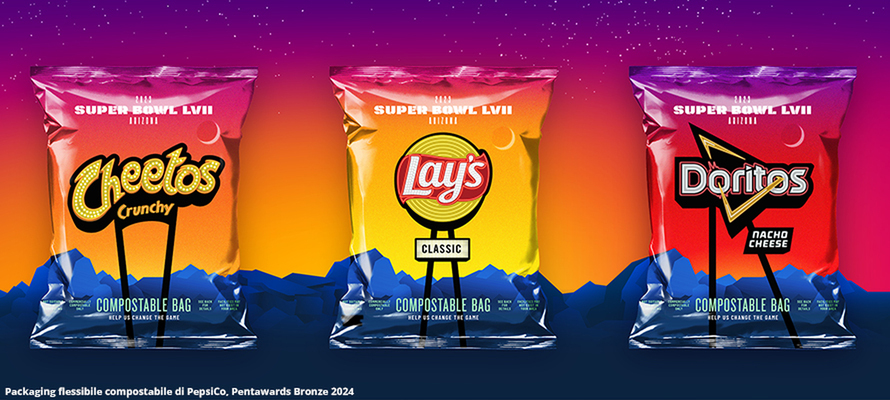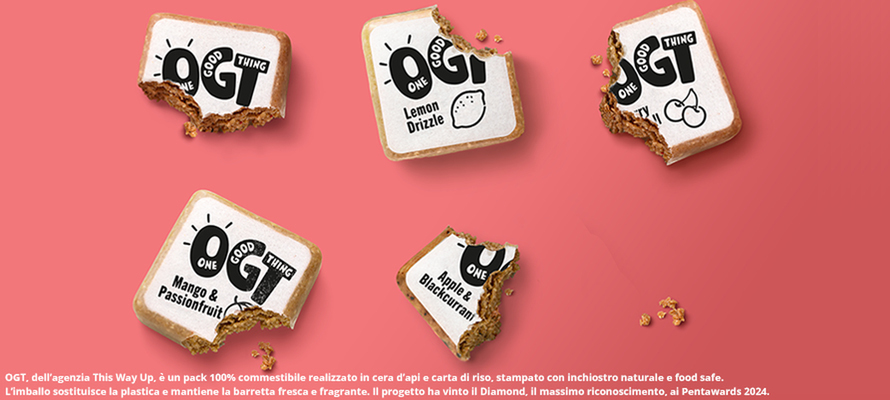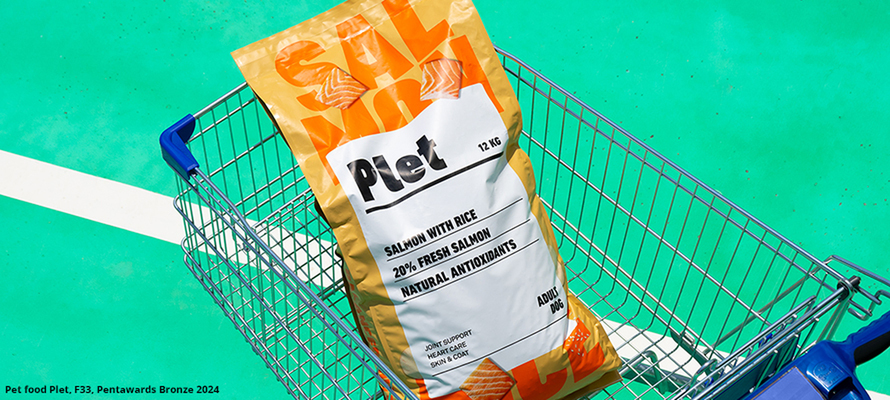The green future of flexible packaging
If the packaging world reflected our society, flexible packaging would be Gen Z: agile, communicative, and now sustainable
By Paola Carbone | on PRINTlovers 106
Defining flexible packaging may seem simple at first glance: a lightweight wrapper, a thin film that wraps, protects, and preserves. Yet, as often happens, the true complexity lies in the details—in the virtuous meeting between material science and the art of communication. Today, innovation emerges from the intersection of functionality, cost-effectiveness, aesthetics, and environmental responsibility.
This is a sector in constant evolution, driven by a double urgency. On the one hand, the need to ensure flawless performance, often dictated by strict regulations—barriers against oxygen, moisture, and light. On the other, the imperative to achieve this while reducing environmental impact. In this context, materials play the starring role in an essential transition. Paper, plastic polymers, and aluminum are combined in complex multilayer structures—or reimagined into simpler, more sustainable solutions.
The increasingly clear trend is toward abandoning heterogeneous laminates in favor of monomaterials, which are easier to recycle. At the same time, new biopolymers are being synthesized that can perform just as effectively as traditional plastics.
Polyolefins: the architects of flexible packaging
If we were to observe a plastic film under a molecular lens, we would see an orderly structure of polymer chains, repeating with almost mathematical precision. These chains, composed of small units called monomers, are characterized by carbon’s covalent bonds. This gives the materials their unique and extraordinary chemical-physical properties—direct results of atomic arrangement and intermolecular interactions.
Among polymeric materials, polyolefins—polypropylene (PP) and polyethylene (PE)—have become the undisputed leaders of flexible packaging. Produced with catalysts that enable chemical reactions and finely control polymer structure, they yield versatile, lightweight yet durable films, adaptable to every packaging need: from medical barrier films to stand-up pouches for food. They bend without breaking, protect without weighing down, and transform into ultrathin films that serve as barriers to oxygen and moisture. In viscous, soft form, they can also be applied as functional coatings through extrusion or coextrusion, enhancing product protection without compromising recyclability.
Their versatility is also evident in multilayer applications, where flexible packaging becomes an engineered system ensuring optimal protection for food and pharmaceuticals. PET provides rigidity and mechanical strength; nylon reduces gas permeability; PE ensures heat-sealing. These polymer architectures preserve the flavor of coffee or extend the stability of an active pharmaceutical ingredient. Yet such complexity presents a major drawback: they are difficult to separate and recycle. Adhesive-bonded laminates often form nearly indissoluble bonds, complicating regeneration of the individual components. For this reason, research is moving toward more sustainable alternatives.
Monomaterials and bioplastics: engineered simplicity
Choosing monomaterials is often driven by sustainability—but also by the desire of brand owners to optimize material and production costs.
A bag of chips, traditionally made from a PET–aluminum–PE laminate, can now be produced entirely from modified polyolefins with nanotechnology or innovative coatings—equally effective but far more recyclable. These films combine the flexibility of PE and PP with oxygen barriers achieved through molecular modifications or additives. In Europe, 30% of new flexible packaging projects are now monomaterial-based.
The path to both environmental and economic sustainability also lies in plant-based plastics. PLA (polylactic acid, derived from corn) was once considered unstable and oxygen-permeable. Today, with engineered additives and nanotechnology-based coatings, bioplastics can match the performance of synthetic polymers. Research is now synthesizing tailor-made bioplastics designed around specific product requirements and shelf-life needs. Starting from bio-based monomers, polymers are being developed that replicate the performance of conventional plastics but with a reduced environmental footprint. These materials are created through microbial fermentation or chemical polymerization of biomass-derived compounds, fine-tuned to provide barriers against moisture, oxygen, and external agents. Bio-based plasticizers and controlled cross-linking further enhance flexibility and mechanical resistance, making the materials suitable for food packaging and compostable industrial films alike. The result: a new generation of high-performing bioplastics, combining functionality and sustainability both in raw material origin and in end-of-life disposal.
Even paper has its barrier
For some products, paper with an ultra-thin functional polymer layer can represent a sustainable alternative to plastics. Dry foods such as cereals, coffee, nuts, flour, and freeze-dried soups require effective protection from moisture and oxygen to preserve freshness and shelf life. Barrier papers, developed with specific polymer coatings, deliver the required performance while maintaining recyclability.
Here too, customization plays a central role: from fiber selection (varying in porosity, strength, and refinement) to coating formulation. Coatings are applied via extrusion, lamination, or water-based deposition. Normal paper is porous and unsuitable as a barrier, but a polymer coating blocks gases, moisture, and fats—crucial for long-shelf-life products. It also provides sealability during packaging, enabling compatibility with automated lines without compromising recyclability.
As a renewable and recyclable material, paper offers a valuable alternative, especially when packaging demands structural rigidity and distinctive aesthetics. Beyond technical performance, paper carries sensory and cultural value: its tactility, visual warmth, and natural feel foster an emotional connection with consumers, a key element in branding strategies.
Printing: the circular aesthetics of the future
If materials form the physical structure of flexible packaging, printing defines its visual and communicative identity. And here lies one of sustainability’s greatest challenges: how to balance high-level chromatic performance, graphic fidelity, and environmental compatibility without undermining cost or efficiency.
Ink research is advancing on several fronts: solvent recovery and reuse, prioritization of renewable oils such as soy and rapeseed, and development of water-based inks. Today, water-based inks can rival traditional formulations in adhesion, resistance, and vibrancy—even for flexible packaging.
Pigments remain more complex. While some colors are derived from natural or mineral sources, most are chemically synthesized. An effective strategy is therefore to optimize usage—reducing ink coverage by up to 30–35% without compromising visual quality. Advanced color management software enables this, cutting raw material consumption, simplifying deinking, and making recycling less energy-intensive.
As for printing technologies, gravure and flexography remain the benchmarks for flexible packaging, striking a balance between quality, speed, and substrate versatility. Innovation now centers on workflow optimization: automating production, reducing setup times, and minimizing waste. Lamination, coating, and varnishing are also being redesigned with low-impact solutions, lowering energy use and CO₂ emissions throughout the process.
Rethinking the wrapper
Once perceived as a symbol of wasteful, polluting consumption, flexible packaging is transforming into a driver of change. No longer an inevitable waste, but the starting point of a revolution sparked by rethinking a simple wrapper. Because today, true luxury—real luxury—can no longer exist without sustainability.
Thanks to:
Marco Scatto – Technology Transfer Expert, Polymer Scientist
Nicola Tisi – Managing Director, Sappi Europe, Sappi Papier Holding GmbH
Ingo Kaiser – Marketing Communications Specialist, Sappi Papier Holding GmbH





